Steemit.com’s skyrocketing Alexa rank appears to be quite impressive.
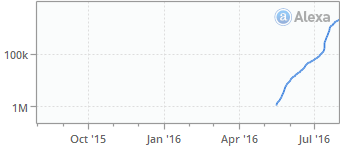
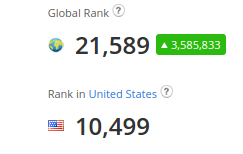
Similarly its skyrocketing Google search popularity.
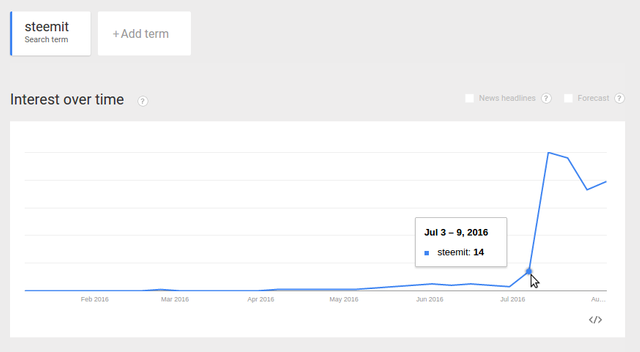
Knock, knock, Ello are you still there?
Yet so was Ello’s skyrocketing launch, until it wasn’t impressive any more.
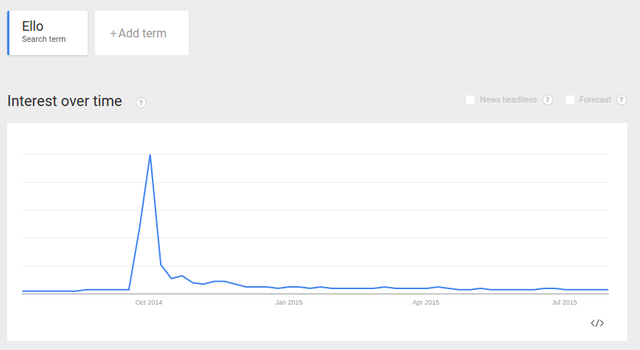
At its peak, Ello had 100,000 signups daily and up to 30,000 signups per hour, which is approximately 100 times more than Steem has now.
Zooming in shows the first peak, pullback, final peak, and one last gasp a month later:
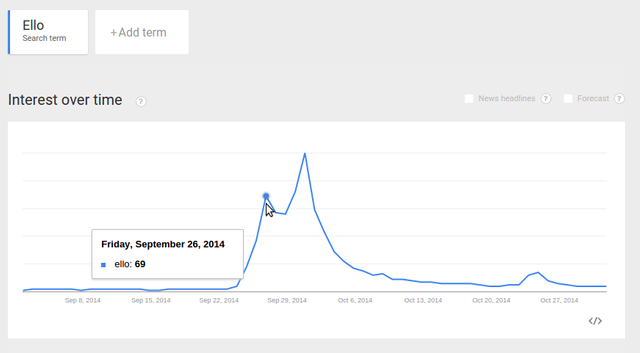
And today Ello is back down to about where Steemit is now at its inception.
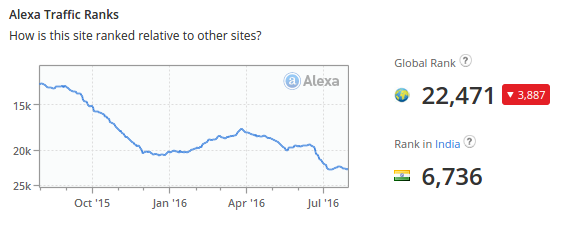
Steem is not Ello nor goodbye?
Of course Steem has some significant differences from Ello. In the minds of the masses, the most prominent difference of Steemit has to be the concept of earning money from blogging. The masses aren’t apt to consider blockchain and crypto-currency technology as a compelling reason to try Steemit. The masses might value the concept that their content production is not owned by any corporate behemoth, i.e. the “anti-Facebook”, which is also what Ello was offering. And they are most likely to associate this with the profits on their content being paid to them rather than to a corporate owner, which is again tied to the concept of earning money from blogging. It is unlikely that the masses will view the blockchain and crypto-currency as important in their priorities here and now. Maybe one day in the future, but our analysis is about what happens this year, not 5 - 10 years from now because the success or failure of Steem will likely be determined over the next months or year or so. Note others might argue that that Steem can slowly improve over many years, yet I would argue that if that is the case then competitors will proliferate. For Steem to slamdunk, it needs to widen its lead pronto with its first-mover advantage.
Where’s the beef?
I have shown some computations that very roughly estimate the attrition (abandonment) rate of Steem to be greater than 80% (and perhaps as high as 94%) of signups. Some claim that many signups might not be real people, but rather attempts to Sybil attack given the monetary gains possible with Steem. Yet I’ve cited numerous anecdotal cases of Steem accounts for real people that appear to have not returned to Steemit in the past week and whose earnings and interaction on the site appears to have been insufficient to sustain their participation.
So although it is not yet clear if Steemit’s reward system and feature set are sufficient to retain and grow usership, certainly this can be a call to action in terms of monitoring these metrics and doing our best to improve on the features that will retain users and hopefully spreading a viral enthusiasm.
Small dogs are cute, but...
Putting the scale into perspective, shows how highly speculative it is to project exponential growth from the first months.
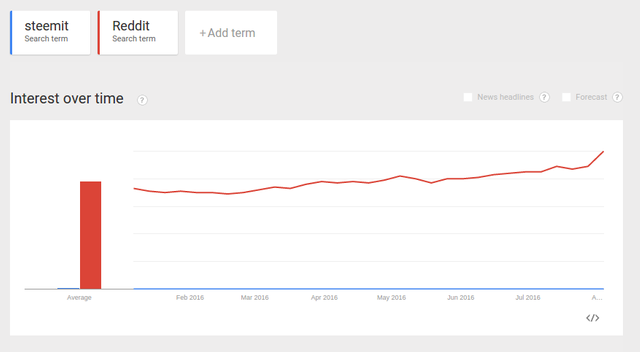
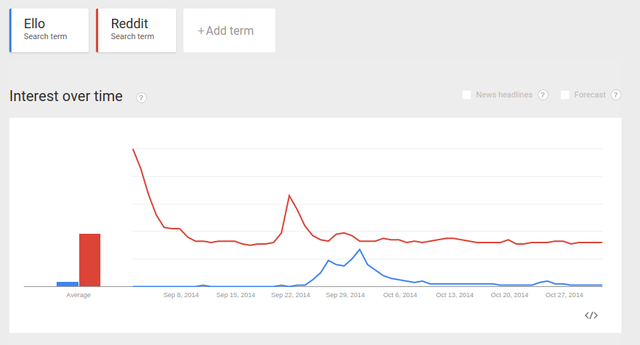
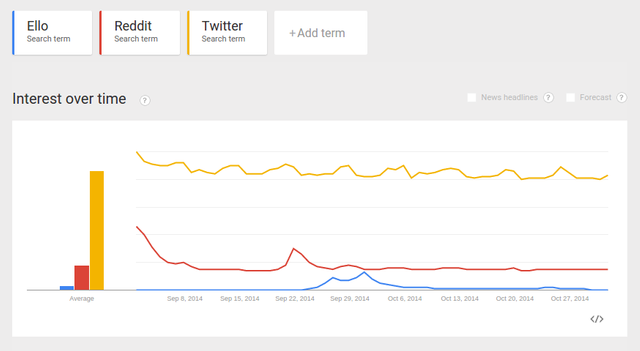
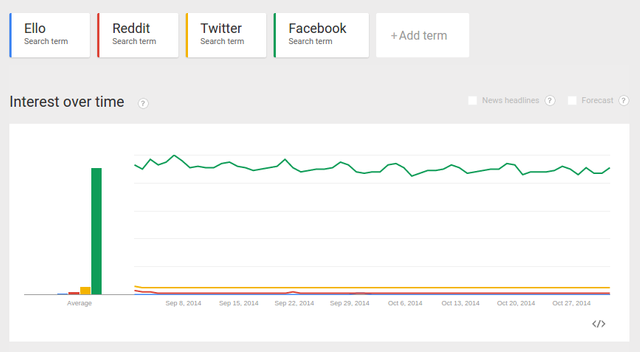
Ello was a network that was trying to compete in the same market segment (free social networks) with other social networks. In other words it was overlapping them and thus the networks with the bigger network effect were more relevant. Even Google is kind'a failing for the same reason with their google plus, despite pushing it down the throats of all its users.
Now, we could argue that after the introduction of steemit the market is fragmented. There was just one market with various players (fb, twitter, reddit, ello, national social networks, etc) playing in that market.
Now that market "monopoly" is broken by a new choice: Paid-Participation Social Networks. So we had one shop in town (free participation) and now we have two (free + user gets paid). When you have one shop which gets all the clients, and then another opens, the first will lose some clients and the second will see a booming growth (as it starts from zero to chew the 100% market share). Even from 0 to 1% is booming growth.
Likewise, in our case, if the unified market has like 2bn users, then if just 1% moves to Steemit due to the incentives of the "new shop", that's 20 million users right there.
When a new option is provided to the market (paid participation) and the former monopoly (give-your-content-for-free) is no more a monopoly / no longer the single option in town, there are booming-market-dynamics in terms of growth.
Now as these people come onboard, there'll be some issues in terms of scaling, in terms of retainment, in terms of usability, etc etc. And there's also the problem that the promise of paid content may not deliver because the userbase may scale x100 to reach 5mn from 50.000, but the rewards cannot follow this booming growth dynamic - and predictably will fail the audience.
At that point the maths of the model may be revisited to increase the reward structure to make it viable - at least that's my prediction.
Downvoting a post can decrease pending rewards and make it less visible. Common reasons:
Submit
There have been other paid participation social networks such as Tsu and ChangeTip. It doesn't appear to be a very compelling feature, because in reality you can't pay very much to users. Each user is only worth on average $20 in revenue per year to Facebook for example. The problem remains how to differentiate with some feature users really need that they can't already get on their existing social networks. Steem attempts to pay $1000s to 2% of the users and the rest get nearly nothing, in attempt to get users to incorrectly assess their earning potential on Steem. But I believe if users only came for the promise of $1000s and instead got only pennies, they leave if there isn't some other compelling feature that other social networks don't have.
Downvoting a post can decrease pending rewards and make it less visible. Common reasons:
Submit
Wow! This is phenomenal and here's a big thank you, plus an upvote! Namaste :)
Downvoting a post can decrease pending rewards and make it less visible. Common reasons:
Submit
It will be interesting to see for sure, If Steemit can snowball fast enough to survive.
Downvoting a post can decrease pending rewards and make it less visible. Common reasons:
Submit
I hope so ! This is so exciting to see how Steemit will do.
Downvoting a post can decrease pending rewards and make it less visible. Common reasons:
Submit
I don't know about ello, is it a similar platform as steemit?
Downvoting a post can decrease pending rewards and make it less visible. Common reasons:
Submit
Take a look what it (was?) about:
Downvoting a post can decrease pending rewards and make it less visible. Common reasons:
Submit
That is one of the reasons I made this blog post, so we can discuss and brainstorm differences.
Downvoting a post can decrease pending rewards and make it less visible. Common reasons:
Submit
To the moon
Downvoting a post can decrease pending rewards and make it less visible. Common reasons:
Submit
Steemit for the win @anonymint!
Downvoting a post can decrease pending rewards and make it less visible. Common reasons:
Submit
Things I see wrong with this,
Attrition rates don't matter too much as long as content is pulling through. You don't need an account to view anything and those who want to earn a buck or participate will sign up.
Active users =/= attrition. Those users could have not signed in this week, chosen to do other things or been a fake account.
Interest over time when not looking at similar timeframes, i.e. start up, growth, maturity.
Comparing the size of sights in meaningless at all points. FB is massive, no one would debate that.
Downvoting a post can decrease pending rewards and make it less visible. Common reasons:
Submit
The Internet is so overloaded with content that we can't even read it all. Content is useless without usership. If you do some Google Trends research, you'll see the blogging (e.g. Medium) isn't nearly as popular as chatting. User engagement is everything. And economies-of-scale in social networks is critically important. Thus attrition rate and comparison in size to behemoths is extremely relevant. Sorry just about everything you wrote is incorrect.
Downvoting a post can decrease pending rewards and make it less visible. Common reasons:
Submit
I agree about blogging vs. chatting. One of the most interesting things I've seen on Steemit is the growth of activity in comments. In the earlier days with a much smaller user base, there were few comments even on the top paid posts. In fact comments were so neglected that there was at one point a proposal to explicitly subsidize comment posting with a dedicated portion of the reward pool. That proposal was dropped, but nevertheless, as the user base grew, comments have taken off to where most decent posts, whether highly rewarded or not, generate a significant tree of discussion and many good ideas are developed in comments.
Anecdotally I hate blogs that disable comments and usually don't return to them more than once or twice. Whether I comment or not, I still want to see what others have to say about the post, and if the poster isn't allowing comments that could potentially challenge their claims, I'm less willing to take what they have to say seriously. The days of one-way information dissemination are over.
Overall this was a good post with useful analysis of the competitive landscape.
Downvoting a post can decrease pending rewards and make it less visible. Common reasons:
Submit
Agreed. Social interaction is key.
Downvoting a post can decrease pending rewards and make it less visible. Common reasons:
Submit
Pleased to Meet You https://steemit.com/online/@ilya.ofilkin/hello-my-name-is-ilya-welcome-to-my-post
Downvoting a post can decrease pending rewards and make it less visible. Common reasons:
Submit